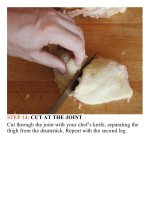The food lab better home cooking through science ( PDFDrive ) 472
Bạn đang xem bản rút gọn của tài liệu. Xem và tải ngay bản đầy đủ của tài liệu tại đây (133.87 KB, 2 trang )
temperature for several hours without any loss of
quality. (Low temperatures and a sealed bag prevent
overcooking or loss of moisture from cooked foods.
This is an invaluable asset, allowing a line cook, or a
harriedspouse,toservehotfoodatamoment’snotice,
withouthavingtoworryaboutprecisetiming.)
3. The ability to tenderize tough pieces of meat.
Traditional braises use relatively high temperatures—
180°F or so—to tenderize tougher cuts. But at these
temperatures,themusclefiberswillexpelquiteabitof
their juices. With sous-vide cookery, much lower
temperatures(sayaround140°F)areappliedformuch
longerperiodsoftime—sometimesupto72hours.The
result is extremely tender meat with no loss of
juiciness. It’s particularly effective for cuts like beef
chuckorshortrib.
4. The ability to cook vegetables without loss of flavor.
Vegetables cooked in vacuum-sealed pouches
naturallysoftenintheirownjuices.Insomecases,this
canbeoverpowering(evertrysous-videceleryroot?),
but in others, the results can be downright
extraordinary.Sous-videcarrotstastemorelikeacarrot
thananycarrotyou’veevertasted.
BeforeIevenbegan,though,Ithrewinthetowelasfaras
categories 3 and 4 go. There’s no way my beer cooler
wouldstaywarmfortherequisite24hours.Previoustesting
had shown me that it loses about 1 degree per hour when
it’sinthe140°to150°Frange.
Vegetablespresentedanevenbiggerproblem.Pectin,the
tough glue that keeps vegetable cells connected, doesn’t
begin to break down until 183°F. Even after only 15
minutes, a beer cooler filled with water this hot will have
cooled by several degrees—it just doesn’t work. So for the
timebeing,itlookslikeifprolonged(2hours+)orrelatively
hot (160°F+) cooking is among your requirements for a
sous-videcooker,you’regoingtohavetospringforthereal
deal.
Ontheotherhand,I’deasilyarguethatcategories1and2
are in fact the primary use of a sous-vide machine—
particularlyforahomecook.AquickGooglesearchofthe
typesofrecipeshomecookshavebeenplayingaroundwith
confirmsthis.
Confident, I then moved on to the field tests, cooking
steaks to 125°F and chicken to 140°F (sound like a
salmonella trap?—we’ll get to food safety in a minute). In
both cases, the results were completely indistinguishable
fromeachother.
Here’s the coolest part: it just so happens that the hot
water from my tap comes out at 135°F—the perfect
temperatureforcookingsteak.Whatluck!
The beer cooler is more easily transportable than a
professional water circulator, and it doesn’t requirean
electricoutlet.So,lastsummer,Iwasabletostartcookinga
2-pound dry-aged rib-eye in my kitchen, carry the whole
cooler out to my deck 2 hours later, slap the beef on a
blazing-hotgrillfor30secondsoneachsidejusttomarkit
and brown the exterior, and then enjoy the most perfectly
cookedmeatthat’severcomeoffmyWeber.Anywhereyou
have access to hot water and a cooler, you can cook sous-









